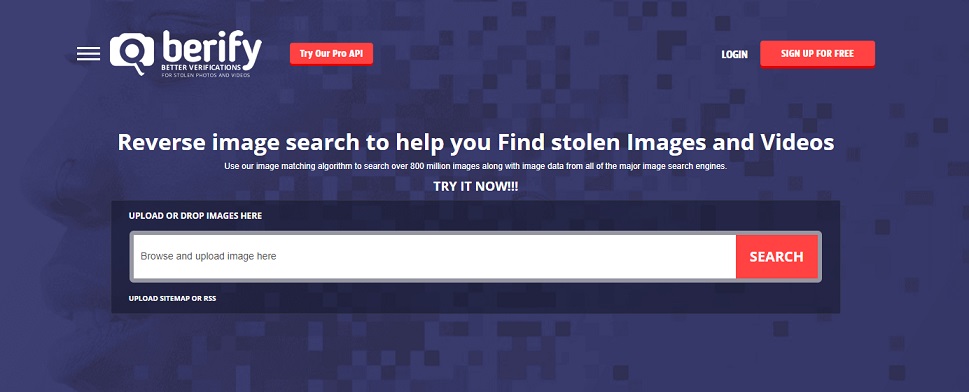Learn How To Reverse Search Videos On Google & Bing – Video Reverse Search – Easy Guide
Discover the art of reverse video searching on Google and through diverse third-party tools. Have you ever pondered how to trace the origins of a specific video? Thanks to technological advancements, this has become more straightforward than ever. Through reverse video search, you can seamlessly and swiftly explore the source of a video. But what if I informed you that this tool has additional capabilities beyond its apparent functionality? Let’s delve deeper into the extended features that reverse video search brings to the table.
What is reverse video search?
When using a search engine, you typically enter a word or keyphrase until you find a page or video that aligns with your search intent. In contrast, a reverse search involves utilizing the search engine to locate every webpage where your item, such as a video, appears. Google and similar search engines analyze the colors and pixels in your video to identify similar or exact copies online. While not always perfectly accurate, this method can be beneficial for assessing the online presence of a video, including its frequency or even its initial appearance.
A reverse video search is a potent technique and tool for extracting online information about videos and images. It employs advanced algorithms that compare the content of an image or video clip with an extensive array of existing sources, enabling more precise searches than ever before.
Although reverse video search technology has been in existence since the early 2000s, its popularity has surged with the continuous growth of digital media. The process relies on object recognition algorithms, which swiftly compare a user’s input with millions of other sources scattered across the web. This approach allows for the rapid identification of specific visual data without the need for manual sifting through large volumes of text-based results.
How Reverse Video Search Works?
Search engines, such as Google, have the capability to analyze the colors and pixels within a video to identify similar or identical videos on the internet. This approach often unveils the original source of the video and any other occurrences of the video online. However, it’s important to note that this process is not always 100% accurate. If even a single pixel in the video has been altered, it may not register in the search results.
Moreover, given the high volume of videos uploaded to the web daily, this method requires search engines to efficiently index all videos to ensure their visibility in search results. The accuracy of the reverse video search depends on the precision of the algorithms employed and the thoroughness of the search engine’s indexing process.
Why Do a Reverse Video Search?
Identifying Illegitimate Usage of Video Content:
For video content creators, conducting a reverse video search unveils instances where your video is featured on various websites. This provides an opportunity to take action by requesting the removal of the content or seeking proper credit.
Locating Full Versions of Videos:
Certain file-sharing platforms, like Reddit or Imgur, may have restrictions on the size of files they can display. If you’re in search of the complete version of a video, a reverse video search can be employed to find it.
Taking a different research approach, a reverse video search on an intriguing video can unveil related content. This enables you to explore and discover similar content that aligns with your interests.
Why do a reverse video search?
Benefits of Reverse Video Search:
1. Verify Content Accuracy:
- Reverse video search is crucial for confirming the accuracy of a video’s content.
- In an era of abundant false or misleading information, conducting a reverse video search ensures access to reliable sources and helps validate the authenticity of the content.
- It serves as a safeguard against copyright infringement by revealing unauthorized use of uploaded clips.
2. Find Similar Videos or Content:
- Utilizing reverse video search allows you to discover similar videos or content related to your initial query.
- This feature is particularly useful when exploring additional topics within a specific area of interest.
- It simplifies the process of locating multiple versions of the same video, such as different edits or renditions, saving time compared to searching individually.
3. Explore Creative Inspiration:
- Reverse video search serves as a tool for exploring creative inspiration.
- By examining existing clips online, you can gather ideas for projects or artwork.
- This approach enables you to develop your unique style and approach to your work by incorporating aspects from various sources, fostering creativity without outright plagiarizing someone else’s work.
Understanding how to conduct a reverse video search, particularly using tools like Google, empowers individuals to enhance content verification, discover related content, and explore creative avenues for inspiration in their projects or artistic endeavors.
How to Use Google Reverse Video Search?
On Desktop
- Open the desired video in your browser or media player.
- Pause the video and capture.
- Take a screenshot using keyboard shortcuts such as PrtScn (Windows) or Cmd+Shift+4 (Mac).
- Go to Google Images and click on the camera icon.
- Choose the “Upload an image” option and select your screenshot from your computer.
- Click on “Search by image” and browse through the results.
On Mobile
- Open the desired video in your browser or app.
- Pause and capture.
- Take a screenshot using gestures like swiping down with three fingers (Android) or pressing power + home buttons (iPhone).
- Download the [Google Photos] app from App Store/Play Store if not already installed.
- Open the Google Photos app and tap on your screenshot. Then, press the Lens icon at the bottom to do a reverse search on Google.
Step-By-Step Guide To Reverse Video Search
Following are the steps to do a reverse video search.
Reverse video search & reverse image search with Google
Google lacks a native reverse video search feature akin to its image search. Nevertheless, there are alternative methods you can experiment with to uncover the origin or content of a video:
Using Google Images (Google Lens) on desktop
Google Images simplifies the process of finding the exact pictures you need. By entering keywords or uploading an image, you receive highly accurate results. Google excels at comprehending images by creating a mathematical representation, which is then compared with images stored in its extensive database. This ensures consistently precise and relevant outcomes. Furthermore, Google considers additional data about the image, such as its description if available.
In 2022, Google Lens took over as the primary visual search tool, replacing the earlier version of Google Image. Despite the shift, the previous version remains accessible through Google Lens. Here are the steps to access it:
- Visit images.google.com and select the camera icon located on the right side of the search bar.
- Next, upload the screenshot of the most distinctive frame from the video, or alternatively, paste a link if it’s available online.

If you lack access to the original file, for example, if you found it on social media, take a screenshot of a distinctive video frame. Upload this screenshot to Google Images. This method is effective even when there are text overlays or watermarks in the picture or video, as they won’t be visible once uploaded to Google Images. If necessary, utilize additional filters like size, color, type, time, and usage rights to tailor your results according to your requirements.
Using Google Lens on mobile
Google Lens allows you to capture an image of any object, providing pertinent information about the item. It goes a step further by recognizing text within images, eliminating the need to type keywords or phrases when identifying items. This feature streamlines the process, delivering results quickly and effortlessly. Performing a reverse image search on Google Lens is a straightforward process, involving only a few simple steps.
To begin, ensure you have an Android phone with access to the Google Play Store and have installed the Google Lens app. Once installed, open the application and tap on the camera icon located at the center of the screen.
Capture a photo using your phone’s camera or choose one from your device’s photo gallery. After selecting an image, press “search,” and Google Lens will display results related to the chosen item. This may include similar pictures online, relevant websites, product information, and more.
For iPhone users, utilize the Google app that incorporates Google Lens. The process remains the same, ensuring a seamless experience in conducting reverse image searches.
Reverse Video Searching Using Third-Party Tools
Method 3. Reverse Search Video with Berify
Berify, a reverse video search engine, is a valuable tool for locating stolen videos and images. Equipped with robust image matching algorithms, Berify provides matching results from popular search engines like Google, Bing, and Yandex. This functionality is especially useful in identifying unauthorized use of your videos and discovering who is using them without permission.
Berify serves as a comprehensive reverse image search tool, offering access to millions of images and videos across various platforms. Its automated image recognition technology is adept at identifying potential copyright violations. Moreover, advanced analytics capabilities empower users to gain insights into the performance of their videos. Berify proves to be an invaluable resource for managing brand presence, safeguarding against unauthorized use, and mitigating potential legal liabilities.

To conduct a reverse video search using Berify, follow these steps:
- Go to Berify and create a Berify account.
- Upload a screenshot of your video and click the Search button.
- Once matching results are found, Berify will send an email to you.
Third-party reverse video search tools employ algorithms to scan websites and online sources, identifying matches with existing media files. This process allows you to quickly identify where the content appears on the web and take necessary actions if required. Additionally, these tools provide valuable insights into user engagement metrics, including views, likes, shares, and comments, facilitating informed marketing strategies and decisions.
For a detailed guide on reverse video search:
- Capture a screenshot of the video’s most distinctive scene or frame.
- Visit the Berify website.
- Upload the screenshot of the video frame you want to investigate and analyze.
- Berify will scan its database and numerous other web sources to find any matching content.
- Berify will generate results in seconds, providing you with immediate findings.
Shutterstock
Shutterstock lets you track down where your shared content has ended up. Using advanced image recognition powered by artificial intelligence, it swiftly sifts through millions of images in its database. This technology helps match them with videos, detecting similarities or edits.
To get started, capture a screenshot of a distinctive frame from the video you’re interested in.
- Next, open your web browser and visit shutterstock.com/video/search/
- Once you’re on the website, click on the camera icon. Choose the screenshot file from your computer or device. After uploading, Shutterstock will generate an image preview and offer various editing options, like adjusting brightness and contrast.
Tineye
Tineye is a user-friendly and potent reverse image search engine. It provides color filtering and facial recognition tools, making it easy to use. The tool can compare images across various platforms, and its algorithms are adept at identifying low-resolution copies. If you’re looking for a reliable option for reverse video searches, Tineye is an excellent choice.
- To get started, capture a screenshot of a frame from the video.
- Next, visit the TinEye website.
- Upload the screenshot file to TinEye by dragging and dropping it into the designated box on their homepage.
- Once uploaded, TinEye will search its extensive database of digital media content to find matches for the provided footage.
- After the search is complete, TinEye will display potential matches found within its library, including related content such as videos with similar frames or scenes. This feature makes it convenient for users to discover additional resources during research or track instances of copyright infringement.
Furthermore, each result includes detailed metadata, enhancing the accuracy and efficiency of identifying the source material.
Practical tips on reverse video search
Lately, reverse video searching has gained popularity, and several third-party tools are now available to aid users. Here are some top tips for successfully conducting a reverse video search on Google and other third-party platforms:
Reverse video search – keywords
The success of a reverse video search on Google relies heavily on the choice of keywords used to describe and locate similar videos. Selecting the right keywords can be challenging, as it involves understanding how to effectively represent the content within the video. It’s crucial to include important details for accuracy in search results while avoiding an excess that might cause relevant information to be overlooked. To approach this task effectively:
Identify Keywords: Brainstorm words and phrases associated with the video, including people, places, objects, and featured activities.
Refine Keywords: Add more specific details like dates and locations mentioned in the clip. Consider using variations of word forms such as nouns and verbs.
Utilize Search Tools: Take advantage of online search tools equipped with advanced filters and sorting options. This helps narrow down results and swiftly pinpoint the ideal video.
Reverse video search – filters
To enhance your searches, make use of the following filters:
Filter by Metadata: Refine results by employing filters such as the author’s name, upload date, and more.
Keyword-Based Filters: Input relevant keywords to customize the query list and guide you towards the desired item.
Language Setting: Adjust the language setting to filter out undesired sources.
Resolution Quality: On some platforms, you can set a specific limit for resolution quality, ensuring only pertinent clips are displayed.
Genre Setting: Specify a particular genre to assist in filtering and narrowing down the results.
Limitations of reverse video search
A reverse video search is a valuable tool for finding information online, but it’s crucial to be aware of its limitations for optimal use. Let’s explore these drawbacks and how to navigate them effectively:
Reliability and Accuracy: Reverse video searches may be unreliable, with accuracy hinging on the quality of the source material. The results can vary based on factors like video resolution and content clarity.
Access Restrictions: Many services limit video access by restricting content to specific regions or languages. This can pose a challenge when attempting to retrieve certain videos that may be confined to particular geographical areas.
Copyright Constraints: Copyright laws may prevent access to certain videos due to licensing agreements between creators and providers. This limitation can hinder the availability of content in reverse video searches.
Technological Limitations: Despite technological advancements, reverse video searches still have limitations in delivering comprehensive results. The scope of their capabilities is not exhaustive.
Understanding these limitations enables users to approach reverse video searches with realistic expectations and explore alternative methods when faced with constraints.
To gather comprehensive information:
- Multiple Keyword Searches: Conduct multiple searches using various keywords related to your topic to ensure a thorough exploration.
- Filter Utilization: Make use of available filters, such as geolocation and language settings, to refine your search results.
- Supplemental Techniques: Use additional techniques alongside reverse video searches when needed for a more comprehensive approach.
- Understanding Copyright Laws: Familiarize yourself with copyright laws applicable to your area to navigate restrictions and permissions effectively.
- Identifying Individuals: When dealing with the identification of individuals, consider supplementing your searches with alternative methods, such as facial recognition software, to enhance accuracy and efficiency.
Applications of reverse video search
The use of reverse video search technology has seen significant growth in various applications over the past decade. It serves multiple purposes, allowing users to identify the source of viral videos, find similar content, and verify the authenticity of videos.
This technology facilitates the swift location of a video’s source, offering information about its origin or creator. For instance, if you come across a viral video clip, such as a prank gone wrong, and want to share it but can’t recall where you found it, a reverse video search helps trace its origins. Moreover, it provides related content that may have stemmed from the original video.
Beyond identifying content sources, reverse video search is valuable for finding similar videos online. This feature assists in discovering additional clips related to ones you already know, offering recommendations based on your previous searches. Additionally, using this tool ensures the authenticity of the material you watch, as many modern platforms integrate verification services into their features.
Key applications include:
- Verifying Origin: Conducting a reverse video search allows you to learn more about where a video or image originated and verify its authenticity.
- Copyright Protection: Access to detailed records enables you to determine if someone has violated copyright laws by sharing specific media files without permission from the creator.
Advantages of reverse video search
Reverse video search proves advantageous in identifying, verifying, and comprehending the content within videos. It holds the potential to offer valuable insights into how information circulates online, enhancing your understanding of the sources behind viral videos more effectively.
Identifying the Source of Viral Videos: Conducting a reverse video search enables you to swiftly and accurately locate images and videos with minimal effort.
Comparing Multiple Versions of Videos: Reverse video searches facilitate the comparison of multiple versions of the same video. This helps track down the original creator and determine whether the video has been altered or edited.
Greater Control Over Digital Content: Utilizing reverse video search provides comprehensive control over your digital assets or content, allowing you to trace other video sources.
Video Search for Investigative Reporting: Professionals, such as journalists, can leverage reverse video searches to uncover crucial materials for investigative reporting purposes.
Analyzing and Interpreting Digital Media: Reverse video search offers an efficient way to analyze and interpret various forms of digital media more accurately and rapidly than ever before.
Reverse video search key takeaways & tips
Reverse Video Searching – FAQs
Q. What is a reverse video search?
A reverse video search is a method of finding a video’s source by using a search engine or specialized tools to analyze the visual content of the video.
Q. Why would I want to do a reverse video search?
You might want to do a reverse video search to find instances of your video appearing on the internet, identify copyright infringements, locate the full version of a video, or discover related content.
Q. How can a reverse video search help me find illegitimate usage of my video content?
By conducting a reverse video search, you can track where your video appears online and identify any unauthorized usage. This allows you to take appropriate actions, such as requesting removal or requesting proper credit for your content.
Q. Can reverse video searching help me find the full version of a video?
Yes, a reverse video search can be useful for finding the full version of a video. It can help you locate instances where the video might be shared on file-sharing sites with size limitations or fragmented across different platforms.
Yes, performing a reverse video search can lead to the discovery of related content. By analyzing the visual elements of a video, search engines or specialized tools can provide recommendations or show similar videos for further exploration.
Q. How can I perform reverse video searches on Google?
To perform a reverse video search on Google, you need to take a screenshot of the video and then follow these steps:
- Go to Google Images.
- Click on the camera icon to search by image.
- Upload the screenshot of the video.
- Google will return search results and any related image data.
Q. What steps do I need to follow to take a screenshot for a video reverse search on Apple/Mac?
To take a screenshot on an Apple/Mac, follow these steps:
- Press Shift + Command + 4.
- Press the mouse or trackpad button.
- Drag over the area you want to capture.
- Release the mouse or trackpad button.
Q. How can I take a screenshot for a reverse video search on Windows?
To take a screenshot for a reverse video search on Windows, follow these steps:
- Press Ctrl + PrtScn keys.
- Use the snipping tool in rectangle mode to capture the chosen video.
Q. What are the steps to run a reverse search on videos on Google using a screenshot?
To run a reverse video search on Google using a screenshot, follow these steps:
- Go to Google Images.
- Click on the camera icon to search by image.
- Upload the screenshot of the video.
- Google will provide search results and relevant image data.
Q. Can I perform a reverse video search on Bing?
Yes, Bing also offers a reverse video search feature that works best with a screenshot.
Q. How do I use Bing’s reverse video search feature?
To use Bing’s reverse video search feature, follow these steps:
- Open Bing’s Visual Search page.
- Select “Browse” and upload your screenshot.
- Bing will provide a search engine results page (SERP) with relevant information.
Q. How does Shutterstock assist in reverse video search?
Shutterstock is a platform with a vast database of images and videos. By using the “Search by Image” button, you can upload a screenshot or specify search criteria to find similar videos or related content.
Q. Can TinEye be used for reverse video search, and how does it work?
TinEye primarily focuses on image search and recognition, but it can be used for reverse video search as well. By uploading an image or pasting its URL, TinEye uses pattern recognition neural networks and machine learning to find instances of that image or video across the web.
Q. Is it possible to perform a reverse video search on mobile devices (iOS and Android)?
Yes, you can perform a reverse video search on mobile devices. However, it requires taking a screenshot of the video on your device.
Q. How do I take a screenshot for a reverse video search on an Android phone?
To take a screenshot on an Android phone, press the Power and Volume Down buttons simultaneously.
Q. What is the process for running a reverse video search on mobile using Google Chrome?
To run a reverse video search on mobile using Google Chrome, follow these steps:
- Open Google Images.
- Access the menu by selecting the three dots at the bottom-right of the page.
- Choose “Desktop site” (Android) or “Request desktop site” (iPhone) to load the desktop version of the website.
- You will now see the desktop version with the camera icon for reverse image search. Upload the screenshot taken on your phone.
Final thoughts on reverse video search
Reverse video search is a valuable tool for content creators, researchers, and curious individuals. It enables you to discover the origin of a video and even find similar videos that draw inspiration from it. Google Images, Google Lens, TinEye, Berify, and Shutterstock are just a few examples of third-party tools that simplify this process. However, the technology has its limitations; it may struggle to provide complete results if the video’s metadata is inaccurate or if the visuals are of low quality.
Despite these limitations, reverse video search remains a valuable asset for anyone seeking to uncover a video’s source. As its advantages continue to grow, technology is evolving, opening up new possibilities in digital media analysis. For those aiming to maximize the potential of digital media files, learning how to use reverse video search on platforms like Google can be incredibly beneficial. Whether it’s verifying videos, tracing the origin of viral content, or identifying similar clips, reverse video search proves to be a strategic approach for extracting the most value from digital media.



